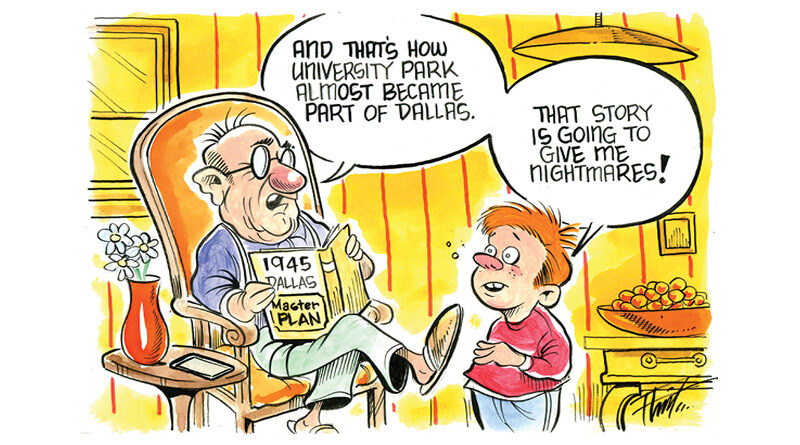How UP Almost Became Part of Dallas
In the spring of 1945, World War II was near its end, and the boys would soon be coming home.
“The Big Three” – the leaders of the Soviet Union, the United States, and the United Kingdom – had met to plan for the defeat of the Axis powers and the shape of postwar Europe.
“No one argues that this master plan of Roosevelt, Stalin, and Churchill can be perfect, but few deny that it is vital to the welfare of humankind,” a front-page Dallas Morning News column read. “Dallas has its master plan, too, and the time for making it effective is now.”
Dallas’ vision for the future included creating a system of parks, erecting a new city hall and auditorium, and stretching its streets and boulevards far north of the city. But that wasn’t going to be possible unless Preston Hollow, University Park, and Highland Park joined with it, becoming part of Dallas.
A vote on unification was scheduled for April 3, 1945, and battle lines were drawn.
“There is no compromise, no middle ground in this for the Park Cities,” resident Julius Runge said. “Either we keep our independence, or it is unconditional surrender.”
The mayor and all the members of University Park’s city commission endorsed unification. City Commissioner Ralph A. Porter announced his support in dramatic fashion, making a statement in favor of the merger just a few hours before he was scheduled to speak in opposition. The president of SMU came out in strong support, as well.
Opponents of Dallas’ master plan called it a “monster plan.” If the Park Cities united with Dallas, “the home environment our sons and daughters have gone to fight for – the home they dream of coming back to will be no more.”
The Park Cities might receive less police protection, zoning ordinances could fall by the wayside, swimming pools could be opened for general use, and the interests of Park Cities voters would be drowned out by those of Dallas at large.
An HPISD School Board member speculated that the school district would be absorbed into Dallas ISD. Taxes could go up, with Park Cities residents eventually paying both Dallas taxes and an additional levy for Highland Park schools.
Tensions mounted before election day, a date which could be either “the finest day Dallas ever had,” Park Cities resident Paul Carrington said, or “the date that Dallas missed the boat.”
Turnout was high, and the result was closer than predicted. Annexation lost in University Park by a margin of just 291 ballots, with 1,726 in favor and 2,017 against.
The next day, there was a parade in Preston Hollow. Dallas officials hopped onto a bus labeled “Preston Hollow, Here We Come” and toured the city, which had voted 300-76 to unify with Dallas.
Unlike in the Park Cities, life in Preston Hollow prior to annexation stunk, according to a 2002 article in the Preston Hollow Advocate magazine. The city had never collected any taxes, and there were few funds to pay for a police or fire department, let alone a sewer system.
To highlight the benefits Preston Hollow residents would receive as part of Dallas, the April 4 parade included a fire truck, a police car, a garbage truck, and a truck hauling two large concrete sewer pipes.
And as for the Park Cities? Dallas wasted no time in annexing everything that surrounded Highland Park and University Park. Dallas Mayor Woodall Rodgers met with supporters and announced that the vote was actually a victory – Park Cities residents had only narrowly defeated annexation and, while they had made a mistake, “eventually, they will correct it.”
“We will cut the pattern to fit the cloth from now on,” he said. “Dallas is on the march because its old-time spirit is aroused.”
Note on sources: Except where otherwise noted, the quotations and information used in this article were sourced from The Dallas Morning News articles published between Dec. 28, 1944, and April 5, 1945.






